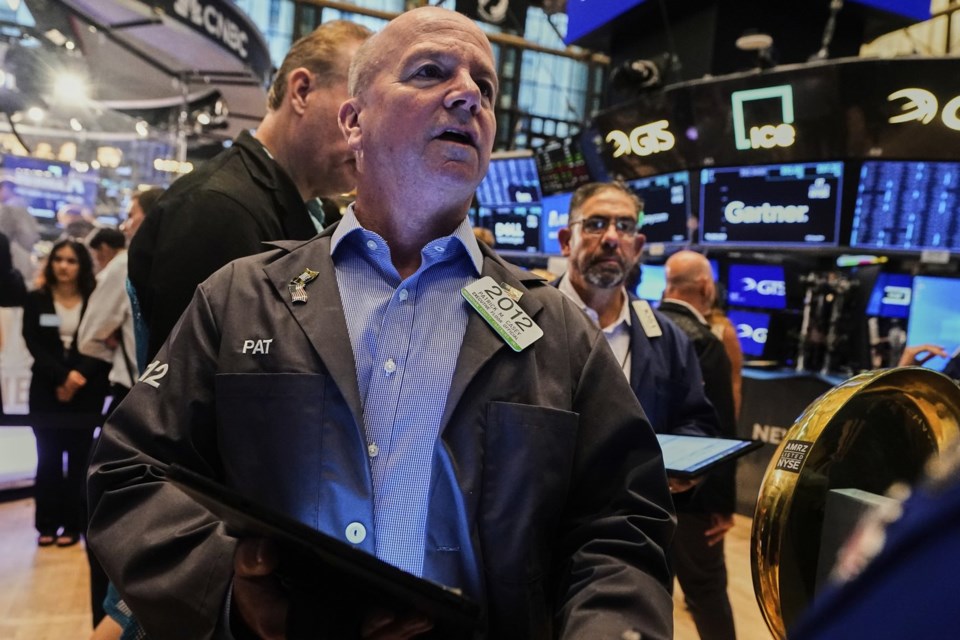NEW YORK (AP) — U.S. stocks climbed near their all-time high after oil prices eased further on hopes that Israel’s war with Iran will not damage the global flow of crude. The S&P 500 rallied 1.1% Tuesday and got back within 0.8% of its record. The Dow Jones Industrial Average rose 1.2%, and the Nasdaq composite jumped 1.4%. Oil prices fell roughly 6% and are below where they were before the Israel-Iran conflict began. That could give the Federal Reserve leeway to cut interest rates to help the economy, and its chair said it’s waiting for the right time to do so.
THIS IS A BREAKING NEWS UPDATE. AP’s earlier story follows below.
NEW YORK (AP) — U.S. stocks are leaping nearly to their all-time high Tuesday after oil prices eased further on hopes that Israel’s war with Iran will not damage the global flow of crude.
The S&P 500 was 1.2% higher in late trading, following up on big gains for stocks across Europe and Asia, after President Donald Trump said late Monday that Israel and Iran had agreed to a “complete and total ceasefire.” The main measure of Wall Street's health is back within 0.8% of its record set in February after falling roughly 20% below during the spring.
The Dow Jones Industrial Average was up 539 points, or 1.3%, with an hour remaining in trading, and the Nasdaq composite was 1.6% higher.
The strongest action was again in the oil market, where a barrel of benchmark U.S. crude fell 6% to settle at $64.37. Brent crude, the international standard, had a similar drop.
The fear throughout the Israel-Iran conflict has been that it could squeeze the world’s supply of oil, which would pump up prices for gasoline and hurt the global economy. Iran is a major producer of crude, and it could also try to block the Strait of Hormuz off its coast, through which 20% of the world’s daily oil needs passes on ships.
Oil prices began falling sharply on Monday after Iran launched what appeared to be a limited retaliatory strike to the United States' entry into the war, one that did not target the production or movement of oil. They kept falling even after attacks continued past a deadline to stop hostilities early Tuesday. Trump later said that the ceasefire was “in effect.”
Oil prices have dropped so much in the last two days that they’re below where they were before the fighting began nearly two weeks ago.
With the global oil market well supplied and the OPEC+ alliance of producing countries steadily increasing production, oil prices could be headed even lower as long as the ceasefire holds and a lasting peace solution can be found, said Carsten Fritsch, commodities analyst at Commerzbank.
Falling oil prices should take some pressure off inflation, and that in turn could give the Federal Reserve leeway to resume cutting interest rates.
Wall Street loves lower rates because they can give the economy a boost by making it cheaper for U.S. households and businesses to borrow money to buy a car or build a factory. But they could also give inflation more fuel. That threat is why the Fed has been hesitant to cut rates this year after lowering them through the end of last year.
The Fed has said repeatedly that it wants to wait and see how much Trump’s tariffs will hurt the economy and raise inflation before committing to its next move. So far, the economy seems to be holding up OK, though a report on confidence among U.S. consumers came in weaker than economists expected on Tuesday, while inflation has remained only a bit above the Fed's 2% target.
Trump, though, has been pushing loudly for more cuts to rates. And two of his appointees to the Fed have said recently that they may consider cutting rates as soon as the Fed’s next meeting next month.
Fed Chair Jerome Powell remains more cautious. He said again in testimony delivered to Congress Tuesday that the Fed is “well positioned to wait to learn more about the likely course of the economy before considering any adjustments to our policy stance.”
But he did indicate the next move is likey to be a cut. Asked whether a reduction could arrive as soon as July, Powell said, “We will get to a place where we cut rates, sooner rather than later – but I wouldn’t want to point to a particular meeting. I don’t think we need to be in any rush because the economy is still strong.”
That helped Treasury yields ease in the bond market. The yield on the 10-year Treasury fell to 4.29% from 4.34% late Monday.
The two-year Treasury yield, which more closely tracks expectations for Fed action, fell to 3.81% from 3.84%.
On Wall Street, cruise operator Carnival steamed 7.9% higher after delivering a much stronger profit for the latest quarter than analysts expected. CEO Josh Weinstein said it's seeing strong demand from people booking cruises close to the departure date, and customers are spending strongly once on board. Carnival also raised its forecast for an underlying measure of profit for the full year.
Uber Technologies rose 8.2% after it said customers in Atlanta can use its app to ride in Waymo autonomous vehicles.
Coinbase Global rallied 13.2% as the cryptocurrency exchange rose with the price of bitcoin, which jumped back above $105,000.
In stock markets abroad, indexes rallied at least 1% everywhere from France to Germany to Japan following the announcement of the Israel-Iran ceasefire. Hong Kong’s jump of 2.1% and South Korea’s leap of 3% were two of the strongest moves.
Stan Choe, David Mchugh And Elaine Kurtenbach, The Associated Press




